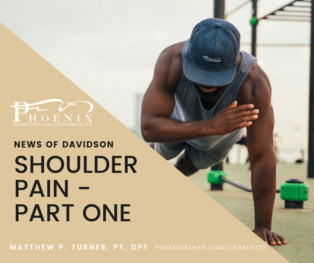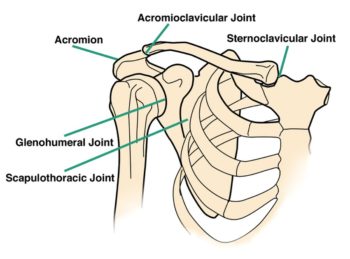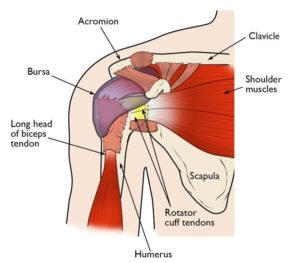FITNESS AND WELLNESS
Shoulder Pain – Part 1

Shoulder pain is a common musculoskeletal complaint that many individuals suffer from at some point throughout their lifetime. Pain around the shoulder can often be described as sharp, nagging, achy, and deep, with an oftentimes slow recovery and recurrence rate as high as 25 percent. It has also been reported that shoulder pain has an occurrence rate of 0.9-2.5 percent throughout the United States.
So, with such a high occurrence rate, what makes injury and pain this common? And what keeps the problem continuing to come back? The answer may be in the anatomy and make-up of the shoulder itself.
 The shoulder complex is made up of three or four separate, but very much interconnected, joints, depending on whom you ask. The three standard joints that make up the shoulder complex include the glenohumeral joint – which is what we typically call our “shoulder joint,” acromioclavicular joint – which sits at the end of your collarbone and is rather ‘pointy’ with certain individuals, and your sternoclavicular joint – which connects your collarbone to your sternum/chest bone. Another joint, the scapulothoracic joint – which joins your shoulder blade to your spine, does not possess the typical characteristics of a joint, but is still needed by your body to allow full arm motion.
The shoulder complex is made up of three or four separate, but very much interconnected, joints, depending on whom you ask. The three standard joints that make up the shoulder complex include the glenohumeral joint – which is what we typically call our “shoulder joint,” acromioclavicular joint – which sits at the end of your collarbone and is rather ‘pointy’ with certain individuals, and your sternoclavicular joint – which connects your collarbone to your sternum/chest bone. Another joint, the scapulothoracic joint – which joins your shoulder blade to your spine, does not possess the typical characteristics of a joint, but is still needed by your body to allow full arm motion.
Your glenohumeral joint is what normally comes to mind when you think of your “shoulder joint.” It is a ball and socket joint that has incredible capacity to rotate and spin, allowing you to move your arm in all sorts of directions and angles. With the high degree of motion comes the risk for instability and overuse injuries, which will be discussed later. In order to combat the risk of hypermobility, you have four muscles collectively called the rotator cuff that help stabilize the joint and keep your arm bone, your humerus, within your glenoid fossa, your socket. These muscles are typically injured during overuse, general aging, or traumatic events.
You also have your acromioclavicular and sternoclavicular joints, which connect your arm to your chest. These joints allow for small motion of rotation and gliding during arm motion, but are vital to allow full, unimpeded arm use. These joints are reinforced by capsules and ligaments that help to limit dislocations or other injuries.
Along with your rotator cuff muscles, your shoulder has a labrum and capsule that surround your glenohumeral joint to provide additional  support and stability. Your labrum increases the surface area of your arm bone and helps to deepen the socket for increased stability. The capsule also allows for attachments of ligaments to help with the integrity and strength of the joint itself – yet another way the body was created to allow for maximal range of motion with built-in stability and protection mechanisms.
support and stability. Your labrum increases the surface area of your arm bone and helps to deepen the socket for increased stability. The capsule also allows for attachments of ligaments to help with the integrity and strength of the joint itself – yet another way the body was created to allow for maximal range of motion with built-in stability and protection mechanisms.
To aid in decreasing potential tissue breakdown, and to allow for improved mechanics and nutrition, the shoulder also has bursae (singular – bursa) that sit throughout the shoulder. The job of the bursa is to decrease friction between surfaces, especially between bone and muscles or tendons, as well as to provide nutritious lubrication throughout the joint.
The main function of the shoulder complex is to allow your arm to move and function appropriately so you can perform your activities of daily living without difficulty. Given the innate complexity of the joint, it is often difficult to pinpoint a single pathology or “cause” of shoulder pain, and oftentimes injuries are caused by a multitude of factors. Injuries and pain within your shoulder complex can be caused by something as simple as acute overuse, whereby a new activity has been performed that has sensitized and potentially inflamed your tissue (overhead painting all weekend, carrying and spreading mulch are a couple of good examples), or something as complex as years of activity that has cumulatively taken its toll on your body as it tries to adapt (poor posture during repetitive overhead lifting while at work).
To further add to the complexity of the shoulder, different parts of the body can refer their pain and discomfort messages to the shoulder area. Certain neck issues and potentially heart or internal organ pathologies can send pain signals to your shoulder, as well as different parts of the shoulder itself can send pain down your arm or spread away from the actual source of the trouble. For these reasons alone, if you have experienced pain throughout your shoulder that doesn’t seem to decrease or improve with activity modification (not just necessarily rest), then it’d be in your best interest to contact a medical provider who can assess your entire body to find the source of your pain.
Check back for Part 2 where we break down the typical causes of shoulder pain and what you can do about them!
Matthew Turner
A native of Sheffield, England, Matthew Turner moved to North Carolina in 2016, with his wife Rachael, and has worked in an outpatient orthopedic setting, specializing in manual therapy. Matt is the Facility Director and lead physical therapist for the PHOENIX Rehabilitation and Health Services, Charlotte location. Matt's clinical expertise focuses on outpatient orthopedics, post-operative conditions, concussion, and sports/work-related injuries. Matt underwent post-graduate training with NAIOMT and is a Certified Manual Physical Therapist. He is also certified in Dry Needling and Blood Flow Restriction Training.


